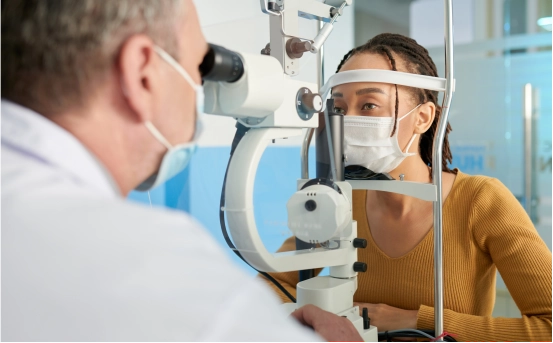Oculoplastic surgery, also known as ophthalmic plastic and reconstructive surgery, focuses on correcting deformities or abnormalities around the eyes, including the eyelids, tear ducts, and orbit (eye socket). It combines ophthalmology and plastic surgery, often restoring both function and aesthetic appearance. But before any surgical intervention, a precise and thorough diagnosis is essential.
Unlike general eye disorders that are diagnosed solely through vision testing, oculoplastic conditions require a more detailed evaluation of the anatomy and function of the surrounding facial structures. From drooping eyelids (ptosis) to orbital tumors or tear duct blockages, each condition demands a unique diagnostic approach.
What is Oculoplastic Surgery?
Oculoplastic surgery includes a broad range of procedures that treat conditions affecting the eye and its surrounding structures. These may include drooping eyelids (ptosis), eyelid tumors, blocked tear ducts, eye socket fractures, thyroid eye disease, or cosmetic concerns like eyelid lift (blepharoplasty).
Before undergoing surgery, a detailed diagnosis helps identify the exact condition, its severity, and any underlying causes that may affect the treatment outcome.
Why Diagnosis is Crucial in Oculoplastic Conditions
The area around the eye is delicate and functionally significant. A poorly diagnosed condition may lead to complications such as impaired vision, dry eyes, corneal exposure, or disfigurement. Therefore, a correct diagnosis is vital for :-
-
Identifying whether the condition is functional or cosmetic
-
Assessing the severity and urgency of the issue
-
Planning the appropriate surgical or non-surgical intervention
-
Avoiding post-surgical complications
-
Enhancing long-term functional and aesthetic outcomes
Common Symptoms That Require Diagnostic Evaluation
Patients are usually referred for oculoplastic diagnosis due to one or more of the following signs or symptoms :-
-
Drooping or sagging eyelids (ptosis or dermatochalasis)
-
Bulging eyes (proptosis or exophthalmos)
-
Tearing or watery eyes (epiphora)
-
Eyelid twitching or spasms (blepharospasm)
-
Eye socket pain or swelling
-
Sudden changes in eyelid position
-
Eyelid lumps or tumors
-
Asymmetry or cosmetic dissatisfaction around the eyes
-
Trauma-related eye changes
These symptoms may result from aging, trauma, infections, tumors, thyroid disorders, congenital abnormalities, or neurological conditions, necessitating a targeted diagnostic approach.
Medical History and Physical Examination
The first step in diagnosing oculoplastic conditions is a thorough consultation. The surgeon takes a detailed medical history, including :-
-
Duration and progression of symptoms
-
History of trauma, surgeries, or systemic diseases (e.g., thyroid dysfunction)
-
Previous ophthalmic treatments or surgeries
-
Family history of eye or genetic disorders
-
Allergies and current medications
A comprehensive physical examination follows, focusing on the eyes, eyelids, tear ducts, surrounding tissues, and overall facial symmetry. The surgeon may evaluate :-
-
Lid position and movement
-
Eyelid laxity or tightness
-
Eye protrusion or recession
-
Tear drainage and tear film quality
-
Skin elasticity and muscle tone
-
Orbital contour and volume
-
Vision quality, including field of vision
Diagnosis of Oculoplastic Surgery
To confirm the diagnosis and plan for surgery, several specialized tests may be recommended depending on the condition:
- Visual Field Test :- This is especially important in ptosis or dermatochalasis, where drooping eyelids may interfere with peripheral vision. The test helps document visual impairment and insurance eligibility for functional procedures.
- Slit Lamp Examination :- A slit lamp is used to magnify and inspect the eyelids, eyelashes, tear ducts, and eye surface. It helps detect structural anomalies or signs of inflammation.
- Tear Drainage Tests :- For patients with watery eyes, dye tests like the fluorescein dye disappearance test or dacryoscintigraphy may be used to assess tear drainage function.
-
Imaging Studies :- Advanced imaging may be required to evaluate deep tissue or orbital abnormalities :-
-
CT Scan (Computed Tomography) :- Useful in trauma, tumors, or orbital fractures.
-
MRI (Magnetic Resonance Imaging) :- Ideal for soft-tissue evaluation in cases like thyroid eye disease or suspected orbital tumors.
-
Ultrasound (B-scan) :- Non invasive imaging for the orbit and retrobulbar space.
-
- Exophthalmometry :- This tool measures the forward displacement of the eye (proptosis), common in thyroid eye disease or orbital tumors.
- Biopsy :- If a tumor or suspicious eyelid lesion is present, a tissue biopsy is conducted to confirm malignancy or benign pathology.
Differential Diagnosis of Oculoplastic Surgery
Some oculoplastic conditions can mimic each other or coexist with other eye disorders. For instance :-
-
Eyelid drooping may result from muscular issues (ptosis), excess skin (dermatochalasis), or neurological problems.
-
Bulging eyes might be caused by thyroid orbitopathy, orbital cellulitis, or orbital tumors.
-
Chronic tearing could stem from nasolacrimal duct obstruction, overproduction of tears, or eyelid malposition.
A careful differential diagnosis ensures the root cause is addressed during surgery, not just the symptoms.
Collaborative Diagnosis with Other Specialties
Many oculoplastic issues are linked with systemic conditions. Surgeons may work in collaboration with :-
-
Endocrinologists for thyroid-related eye disease
-
Neurologists for muscle or nerve-related eyelid conditions
-
Oncologists for orbital or eyelid tumors
-
ENT specialists for lacrimal system disorders
Such interdisciplinary coordination ensures comprehensive diagnosis and better surgical outcomes.
Pre Surgical Counseling and Photographic Documentation
Once the diagnosis is confirmed, the surgeon typically conducts :-
-
Pre surgical counseling regarding goals, risks, and expectations
-
Clinical photographs to document the condition and monitor post-surgical progress
-
Discussion of anesthesia options and post-operative care
This stage also gives the patient an opportunity to ask questions and express concerns, ensuring informed consent and realistic expectations.
Conclusion
The diagnosis of oculoplastic surgery is a multi layered process that blends clinical expertise with imaging and functional tests. Whether you’re dealing with drooping eyelids, blocked tear ducts, or orbital deformities, accurate diagnosis is the cornerstone of successful treatment.























